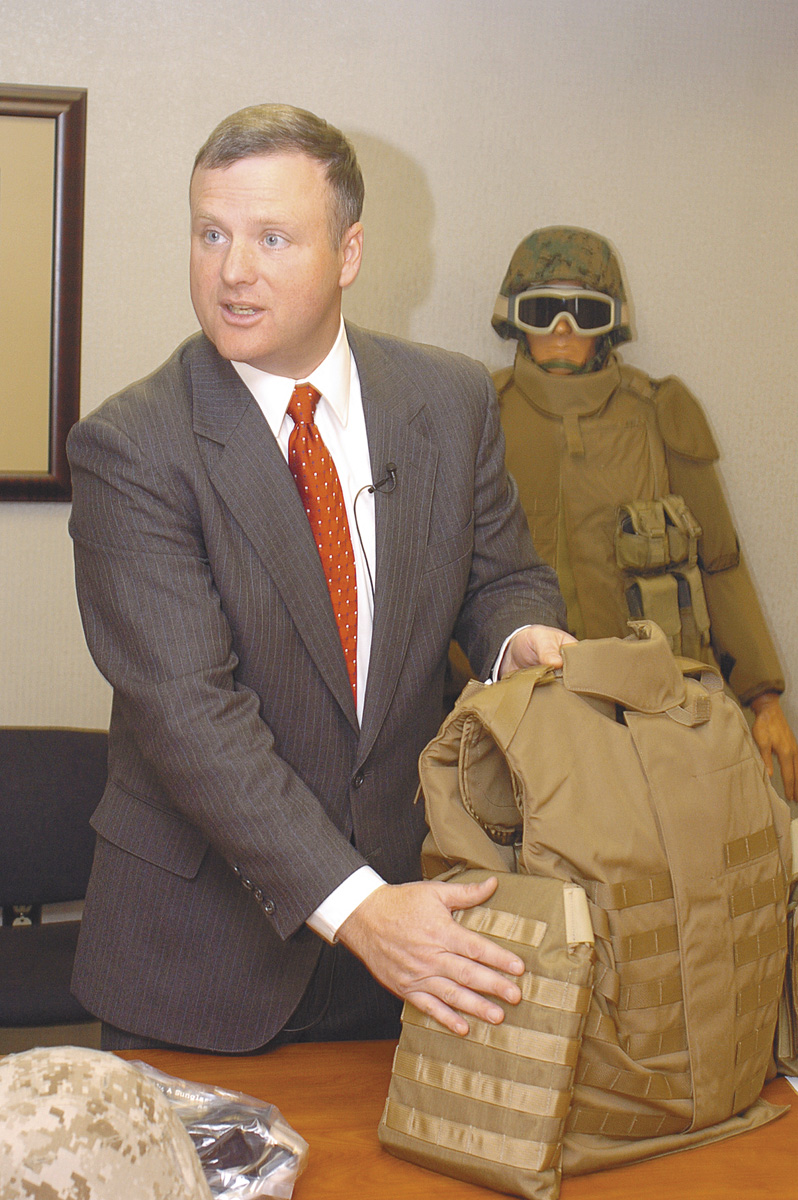|
Interceptor Body Armor System
The Interceptor multi-threat body armor system (IBA) is a bullet-resistant body armor system that was used by the United States Armed Forces during the 2000s, with some limited usage into the mid-2010s. IBA and its design replaced the older standardized fragmentation protective Personnel Armor System for Ground Troops (PASGT) body armor system that was designed in the late 1970s and introduced in the early 1980s. The IBA system consists of its core component: the outer tactical vest (OTV), which can optionally be worn with a throat protector, groin protector, and biceps (or deltoid) protector. The latter three auxiliary protectors are removable from the main vest, which can be worn alone. IBA was designed in the late 1990s as a replacement for the PASGT vest and the essentially-improvised ISAPO supplemental armor plate carrier, a combination widely criticized by US troops for its immense weight. It comes in a variety of color schemes and camouflage patterns depending on who th ... [...More Info...] [...Related Items...] OR: [Wikipedia] [Google] [Baidu] |
Coyote Brown
Coyote brown, also known as nutria brown, is a color often used in military camouflage. It is a dull yellowish brown. See also *List of colors *MARPAT *MultiCam References Shades of brown {{color-stub ... [...More Info...] [...Related Items...] OR: [Wikipedia] [Google] [Baidu] |
Federal Prison Industries
Federal Prison Industries, Inc. (FPI), doing business as UNICOR (stylized as unicor) since 1977, is a corporation wholly owned by the United States government. It was created in 1934 as a prison labor program within the Federal Bureau of Prisons. Under US federal law, all physically abled inmates who are not a security risk or have a health exception are required to work, either for UNICOR or at some other prison job.Title XXIX, §2905 of the Crime Control Act of 1990 (P.L. 101-647) required that all offenders in federal prisons must work (the act permitted limitations to this rule on security and health-related grounds). As of 2021, inmates earned between $0.23 to $1.15 per hour. As a "mandatory source" for federal departments (having priority over all other sources, including JWOD sources from blind or severely disabled persons), FPI receives priority in any purchases of its products. UNICOR is entirely self-sustaining and has no cost to US taxpayers. History A statute ... [...More Info...] [...Related Items...] OR: [Wikipedia] [Google] [Baidu] |
All-purpose Lightweight Individual Carrying Equipment
The all-purpose lightweight individual carrying equipment (ALICE) is a set of load-carrying equipment, adopted as United States Army Standard A on 17 January 1973. The ALICE system was developed from 1967 to 1972 in the LINCLOE (lightweight individual combat clothing and equipment) program, and was initially designated the M-1972 lightweight load-carrying equipment equipment (LLCE), switching to the ALICE name shortly afterward. ALICE replaced the M-1956 individual load-carrying equipment (ILCE) and M-1967 modernized load-carrying equipment (MLCE). In 1988, the individual integrated fighting system (IIFS) was introduced to compliment the ALICE pack and suspenders, mainly addressing center of gravity and storage space capability shortcomings. IIFS, however, was plagued by production quality control issues, and was only partially phased into service. Although since superseded by MOLLE, ALICE gear is still in some limited use with the U.S. Army National Guard, State Guard, al ... [...More Info...] [...Related Items...] OR: [Wikipedia] [Google] [Baidu] |
MOLLE (military)
Modular lightweight load-carrying equipment, or MOLLE (pronounced ), is the current generation of load-bearing equipment used by the United States Army. MOLLE equipment uses Pouch Attachment Ladder System (PALS)-type webbing – rows of heavy-duty nylon stitched onto the gear – to attach pouches. This method has found use on civilian gear, and as a result, the term 'MOLLE' is used outside the military for any equipment generally using PALS-type webbing. The system's modularity results from the PALS allowing for the attachment of various compatible pouches and accessories. This method of attachment has become a ''de facto'' standard for modular tactical gear, replacing the all-purpose lightweight individual carrying equipment (ALICE) clips and webbing used in the earliest modular vest systems. The MOLLE system replaced the aging ALICE equipment, adopted in 1973, and the Individual Integrated Fighting System (IIFS) used since 1988 in US Army and Marine Corps service. Bac ... [...More Info...] [...Related Items...] OR: [Wikipedia] [Google] [Baidu] |
PALS Webbing
The Pouch Attachment Ladder System or PALS is a grid of webbing invented and patented by United States Army Natick Soldier Research, Development and Engineering Center used to attach smaller equipment onto load-bearing platforms, such as vests and backpacks. It was first used on MOLLE rucksacks, but is now found on a variety of tactical equipment, such as the U.S. Improved Outer Tactical Vest, Interceptor body armor, USMC improved load-bearing equipment backpack and Modular Tactical Vest. It is used to attach items such as holsters, magazine pouches, radio pouches, knife sheathes, and other gear. A wide variety of pouches are commercially available, allowing soldiers to customize their kit. There is also a variety of attachment methods including the Alice Clip, the Natick snap, and soft, interwoven straps. The PALS system has begun to be adopted by other forces, such as the British Army, who use it on their Osprey body armour, Osprey body armor. PALS consists of webbing sewn onto ... [...More Info...] [...Related Items...] OR: [Wikipedia] [Google] [Baidu] |
Kevlar
Kevlar (para-aramid) is a strong, heat-resistant synthetic fiber, related to other aramids such as Nomex and Technora. Developed by Stephanie Kwolek at DuPont in 1965, the high-strength material was first used commercially in the early 1970s as a replacement for steel in racing tires. It is typically spun into ropes or fabric sheets that can be used as such, or as an ingredient in composite material components. Kevlar has many applications, ranging from bicycle tires and sailcloth#Kevlar, racing sails to bulletproof vests, due to its high Specific strength, tensile strength-to-weight ratio; by this measure it is five times stronger than steel. It is also used to make modern marching drumheads that withstand high impact, and for Mooring, mooring lines and other underwater applications. A similar fiber, Twaron, with the same chemical structure was developed by Akzo in the 1970s. Commercial production started in 1986, and Twaron is manufactured by Teijin Aramid. History Poly- ... [...More Info...] [...Related Items...] OR: [Wikipedia] [Google] [Baidu] |
Small Arms Protective Insert
The Small Arms Protective Insert (SAPI) is a ceramic ballistic plate used by the United States Armed Forces. It was first used in the Ranger Body Armor and Interceptor Body Armor, both are ballistic vests. It is now also used in the Improved Outer Tactical Vest as well as the Modular Tactical Vest, in addition to commercially available "plate carriers". The Kevlar Interceptor vest itself is designed to stop projectiles up to and including 9×19mm Parabellum submachine gun rounds, in addition to fragmentation. To protect against higher-velocity rifle rounds, SAPI plates are needed. ESAPI In May 2005, the U.S. Armed Forces began replacing the standard Small Arms Protective Insert plates with the Enhanced Small Arms Protective Insert (ESAPI). An ESAPI provides protection from .30-06 Springfield M2 armor-piercing (AP) with a steel penetrator in accordance with the NIJ Level IV standard, but costs about $600 per plate, 50% more than SAPI plates. They are produced by Ceradyn ... [...More Info...] [...Related Items...] OR: [Wikipedia] [Google] [Baidu] |
Scalable Plate Carrier
The Scalable Plate Carrier (SPC) is a plate carrier used by the United States Marine Corps as an alternative to the heavier Modular Tactical Vest (MTV). History Design It is a lightweight plate carrier intended to supplement the Modular Tactical Vest. Key issues with the previous MTV, specifically ergonomics, have been remedied with the addition of new features such as adjustment buckles and improved padding on the shoulders. These new improvements are intended to make the vest much more comfortable to wear in comparison to the MTV. It resembles the Eagle Industries MBAV and has staggered MOLLE webbing on the chest. First generation The SPC was fielded to combat units operating in the War in Afghanistan (2001–present), War in Afghanistan in 2008 as a lightweight alternative to the MTV, where it has proved popular because of the region's mountainous terrain. Marines now typically deploy with both the MTV and SPC, with commanders setting the requirements for which vest shou ... [...More Info...] [...Related Items...] OR: [Wikipedia] [Google] [Baidu] |





